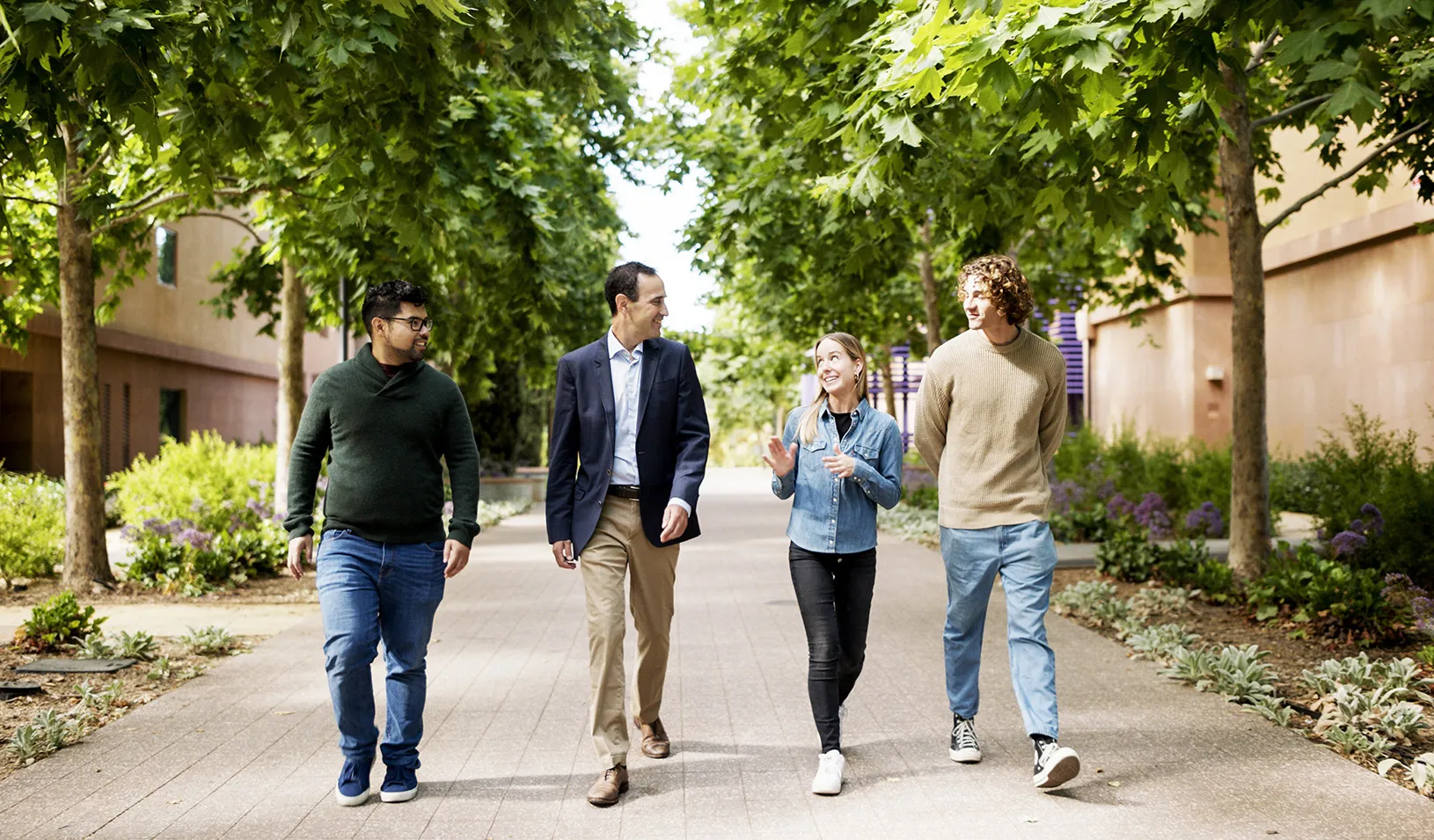From the Dean: Staying Ahead in the Digital Age
“Effective leaders in the digital age will need to be mindful of the social consequences of technology.”
February 27, 2018

From left to right: Michael Ostrovsky, Guido Imbens, Dean Jonathan Levin, and Susan Athey | Toni Bird
One of the most important forces in business today, and in our broader society, is the ongoing developments in data science, artificial intelligence, and automation. Innovations in these areas are likely to have enormous social benefits in coming years, improving health, education, transportation, and other sectors in the United States and around the world. At the same time, these innovations bring significant concerns related to privacy, security, the future of work, and equality of opportunity. Indeed, as computers become better at a wider array of human tasks, these technologies may raise questions about what it means to be distinctively human.
At Stanford GSB, we are at the center of these coming technological advances. We are surrounded by the scientists and engineers, on the Stanford campus and in industry, who will bring many of these advances to reality. And it is important for us to recognize that most of the investments in technology, and most of the advances, are likely to come from business, and hence the decisions of business leaders will be central to the direction these technologies take.
These leaders will need to be attuned to the opportunities for new products and services that are opened up by data science, artificial intelligence, and automation, and the way these technologies will change business processes. Some of these opportunities are readily apparent, such as the potential for autonomous vehicles, or highly capable virtual assistants, or for greater automation in manufacturing and financial services. Other applications will be dreamed up by innovative entrepreneurs, perhaps in industries such as healthcare and education, where productivity growth historically has been relatively slow.
As these opportunities take shape, effective leaders in the digital age will need to be mindful of the social consequences of technology. Technological advances over the last 40 years largely have favored workers with greater skills and training. They are a primary reason that the college wage premium has risen over several decades, and that college-educated workers in the U.S. today earn over 60% more than high school-educated workers. Technology also has led to the creation of winner-take-all markets that can generate vast wealth for a relatively small number of people. Technological progress is likely among the reasons why the top 1% of earners have captured more than half the total income gains in the U.S. economy over the last 25 years.
Today, many observers believe that the coming changes from automation will have even more dramatic effects and could be different from previous technological revolutions in several ways. First, they will be global. A recent study by McKinsey projected labor force effects from automation that are as big in developing economies, especially China and India, as in the U.S. and Europe. Second, there is a plausible concern that increases in the overall demand for jobs will not keep pace with improvements in automation, resulting in persistent unemployment. This concern has been raised in previous technological revolutions and has not been borne out, but it cannot be ignored.
Finally, changes in work will be only one of the social effects of new digital technologies. The industrial revolution led to vast social changes — migration to cities, improvements in education, new areas of regulation, and significant changes in governance in the private and public sector. The ongoing digital transformation is likely to have similarly sweeping effects over a period of decades.
Our faculty at Stanford GSB are already grappling with these issues and bringing them into our classrooms. Faculty such as Mohsen Bayati, Guido Imbens, Susan Athey, and Stefan Wager are developing new methods for machine learning, often with business applications. Mohsen’s course on Business Intelligence from Big Data explores how big data analytics can drive competitive advantage. This summer we will introduce a new Executive Education course titled Big Data, Strategic Decisions: Analysis to Action.
Our faculty also are focused on new business models and regulatory approaches. Michael Ostrovsky’s recent work explores how to regulate self-driving cars, while Keith Hennessey offers a course on the future of mobility. Michal Kosinski has written extensively about the threats to privacy posed by artificial intelligence algorithms. This spring, Stanford GSB’s Value Chain Innovation Initiative, under the leadership of Hau Lee and Haim Mendelson, will host a conference on artificial intelligence in value chains. And Steve Callander recently launched the Policy and Innovation Initiative, which is convening business leaders and policymakers to discuss regulation and public policy issues for technology companies. Collaborating with industry and government is essential if we are to have a voice in business and policy.
Partnerships across the Stanford campus bringing together technologists, social scientists, and humanists are fundamental to our leadership in these areas. Several of our faculty are already participating in campus groups thinking through the future of data science and “human-centered” artificial intelligence. And this month we partnered with the Stanford AI Lab to sponsor a seed grant program for collaborative research on artificial intelligence. We were thrilled (and a bit stunned!) when almost 90 teams from across Stanford submitted proposals.
It is an exciting time at Stanford GSB and Stanford, and I expect our budding collaborations to be just the start given the way technology is evolving, and the implications data science, artificial intelligence, and automation will have on business and society. I look forward to Stanford GSB taking on a vanguard role in thinking through the opportunities and challenges of coming digital technologies and in collaborating with business, social, and policy leaders.
—Jonathan Levin, the Philip H. Knight Professor and Dean of Stanford GSB
For media inquiries, visit the Newsroom.
Explore More
Erin Nixon Joins Stanford GSB as Assistant Dean of Admissions

Nia Rose Froome, MBA ’23: Making Local, Fresh Food Available for All

New Research Fund Promotes Responsible Leadership for the Next Century
